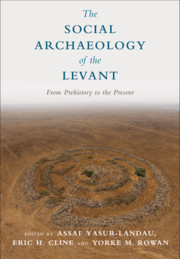Book contents
- The Social Archaeology of the Levant
- The Social Archaeology of the Levant
- Copyright page
- Contents
- Figures
- Tables
- Contributors
- Foreword
- Acknowledgments
- Abbreviations
- Prologue
- Part One
- Part Two
- Part Three
- Part Four
- Twenty One People, Material Culture, and Ethno-Religious Regions in Achaemenid Palestine
- Twenty Two Land/Homeland, Story/History
- Twenty Three The Effects of Empire on Daily Life in the Provincial East (37 BCE–313 CE)
- Twenty Four The Social Archaeology of the Southern Levant in the Byzantine Period
- Twenty Five Rural Communities and Labor in the Middle Islamic-Period Southern Levant
- Twenty Six Society in the Frankish Period
- Part Five
- Part Six
- Epilogue
- Index
- References
Twenty Four - The Social Archaeology of the Southern Levant in the Byzantine Period
Rethinking the Material Evidence
from Part Four
Published online by Cambridge University Press: 14 December 2018
- The Social Archaeology of the Levant
- The Social Archaeology of the Levant
- Copyright page
- Contents
- Figures
- Tables
- Contributors
- Foreword
- Acknowledgments
- Abbreviations
- Prologue
- Part One
- Part Two
- Part Three
- Part Four
- Twenty One People, Material Culture, and Ethno-Religious Regions in Achaemenid Palestine
- Twenty Two Land/Homeland, Story/History
- Twenty Three The Effects of Empire on Daily Life in the Provincial East (37 BCE–313 CE)
- Twenty Four The Social Archaeology of the Southern Levant in the Byzantine Period
- Twenty Five Rural Communities and Labor in the Middle Islamic-Period Southern Levant
- Twenty Six Society in the Frankish Period
- Part Five
- Part Six
- Epilogue
- Index
- References
- Type
- Chapter
- Information
- The Social Archaeology of the LevantFrom Prehistory to the Present, pp. 458 - 477Publisher: Cambridge University PressPrint publication year: 2018

